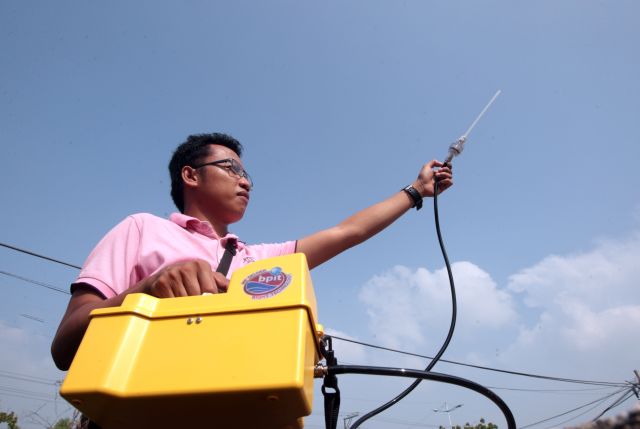
HAZE? Arthur Nino Calupig, DENR environmental management specialist uses an instrument to take samples in five Metro Cebu areas. Pagasa Mactan reports poor visibility in Cebu. (CDN PHOTO/TONEE DESPOJO)
Pagasa notes poor visibility in Cebu; EMB takes air samples with new gear
Cebu had gloomy skies and visibility was poor as a team from the Environmental Management Bureau (EMB) took air samples using a new gas tester yesterday.
Was it haze from Indonesia again?
EMB personnel said they will know when test results come out next week.
The new equipment will check for levels of nitrogen dioxide (NO2), sulfur dioxide (SO2) and methane which are pollutants from vehicle exhaust and factories.
However, Mactan weather bureau chief Alfredo Quiblat and atmospheric physicist Gerry Bagtasa said they believe it was haze from ongoing forest fires in Indonesia.
He posted a video on the haze transport mechanism on his Facebook page WeatherManila.
“I can confidently conclude that the haze mostly in Visayas and Mindanao is from Indonesia,” he told CDN. Dr. Bagtasa is the deputy director for research of the UP Institute of Environmental
Science and Meteorology and head of the Atmospheric Physics Lab.
Haze is defined by Pagasa as particles of fine dust suspended in the air that produce limited visibility. Smog, on the other hand, is a combination of pollution and fog.
HAZE TRANSPORT
Dr. Bagtasa said he ran a computer model – the same used to forecast weather – and analyzed satellite imagery on Oct. 14 to 21.
“I still plan to run the model for a longer duration to better see this transport because it seems that after Lando, another typhoon that was headed to Japan was the culprit in moving the smoke toward the Philippines,” he said.
“Also looking at satellite images, it appears that it is indeed long-range transport of haze,” he added.
He concluded earlier that both smog and haze covered Cebu from Oct. 1 to 4. Smog is a mixture of smoke and sulfure dioxide while haze is caused by suspended particles that reduce visibility.
Quiblat, for his part, said “it is possible that it is haze from Indonesia because the two countries are near and in the Philippines, we don’t experience any smoke from fire or volcanic eruption.”
POOR VISIBILITY
Quiblat said sky visibility yesterday was less than five kilometers, about half of the normal visibility level of 10 kilometers for airplanes.
“It is poor visibility when it is less than 5 kilometers. This means there is obstruction in the sky,” he said.
The Philippine Atmospheric Geophysical and Astronomical Services Administration (Pagasa) said it was up to the pilots to decide whether to proceed with their trips.
No flights were cancelled at the Mactan Cebu International Airport yesterday.
The EMB team yesterday took air samples from five areas – in front of the Talisay City Hall, Fuente Osmeña Circle, Marco Polo Hotel parking lot, Tops and the Cebu International Convention Center (CICC).
NEW TESTER
They used a new gas tester to check the levels of nitrogen dioxide (NO2), sulfur dioxide (SO2) and methane in the air.
“We confirmed it (haze from wildfires in Indonesia) in some parts of Mindanao already through our EMB counterpart there. However, for Metro Cebu, let’s wait for the results to come out,” said
Department of Environment and Natural Resources (DENR) information officer Dr. Eddie Llamedo.
Engr. Cindyln Pepito, chief of the Ambient Quality Monitoring section of the EMB 7, said that although they can measure the levels of gases in the air, they can’t easily point to one industry, activity or cause.
“As per our central office, there’s a possibility that it may come from Indonesia. Before, during our previous testing, there were no complaints in Mindanao, only in Cebu. But now, we’re already looking at it since there are also observations in Mindanao already,” she said.
Results of their monitoring on Oct. 1 and 2 showed that air quality in Cebu ranged from “fair to good.”
TRACERS
In his e-mail, Dr. Bagtasa said one of the ways to verify the haze is to measure “tracers” for biomass burning or smoke from burning vegetation.
But even if this tracer is measured, he said there is still no certainty about its source.
“Satellite images that I checked recently showed there were some biomass burning locally as well,” he added.
While waiting for the results, DENR is advising the public to remain cautious. “Although we are awaiting the results, we advise the people not to stay longer in any outdoor activities and lessen prolonged or strenuous outdoor physical exertion. Those who are sick especially the elderly and children should stay indoors,” Llamedo added.